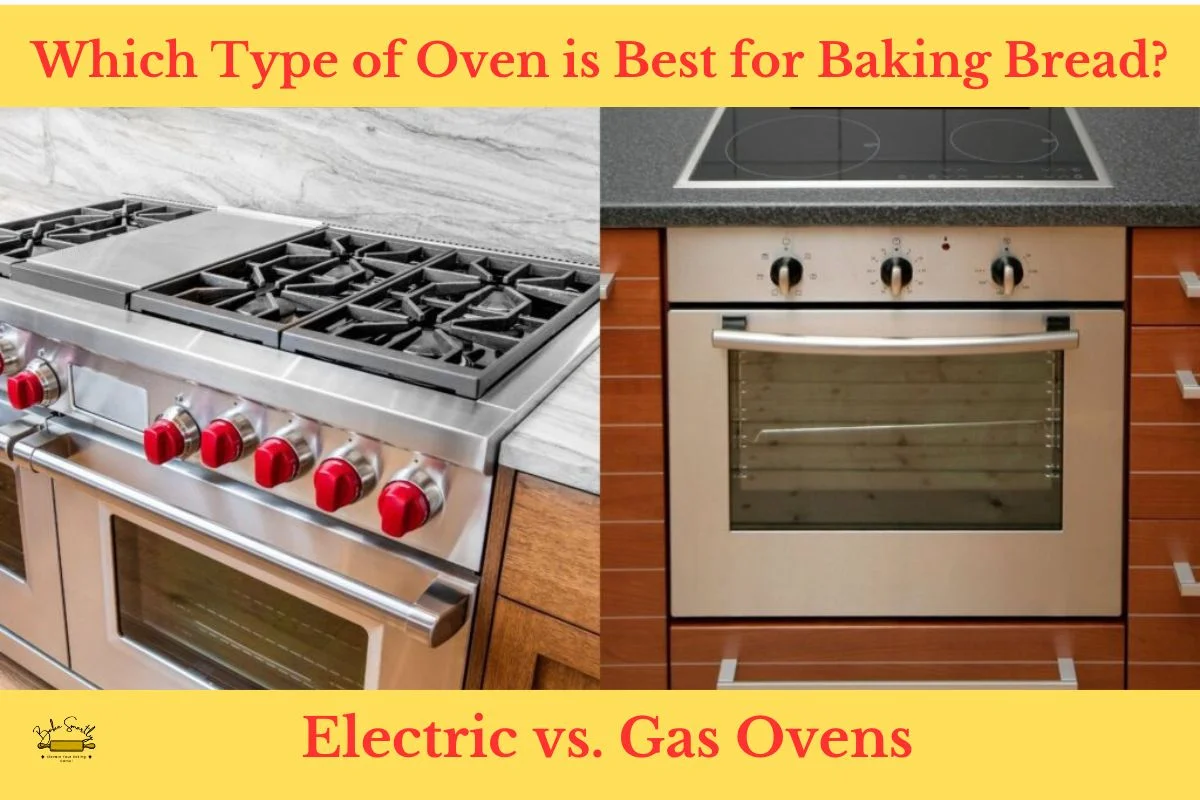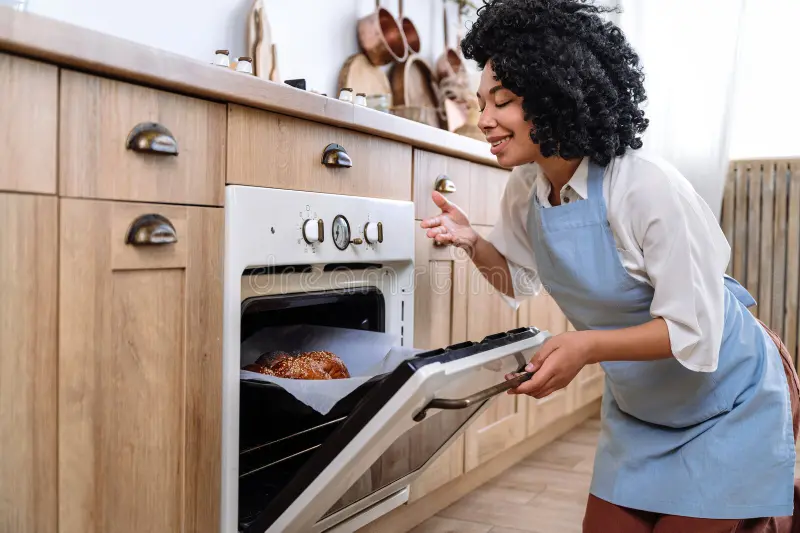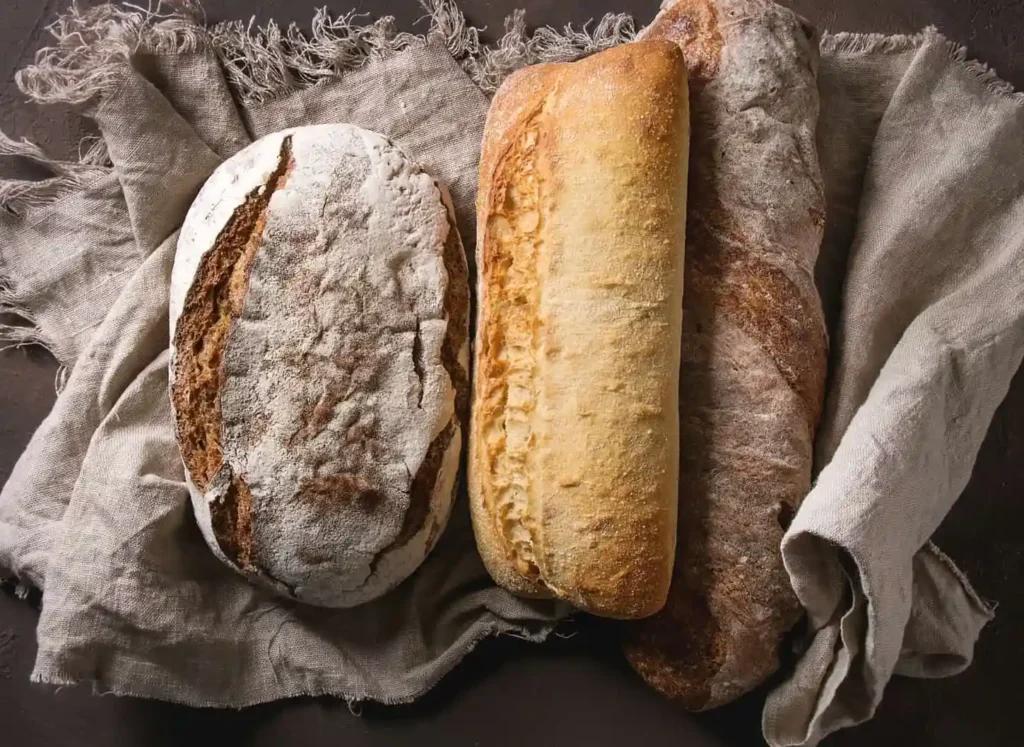
Electric vs. Gas Ovens: Which Type of Oven is Best for Baking Bread?
When it comes to the art of baking bread, I’ve learned through my years of experience as an expert baker that choosing the right oven is absolutely crucial. You see, there’s this one time when I was just starting out as a baker.
I was so excited to bake my first batch of artisanal bread. I had carefully crafted the dough, let it rise to perfection, and was all set to pop it into the oven. But there was a twist – I had two ovens at my disposal, one electric and the other gas-powered.
I stood there, torn between the two, knowing that the decision I made would significantly impact the quality of my homemade loaves.
So, I decided to weigh the pros and cons of both types of ovens, just as I’m about to share with you in this article, to help you make an informed decision for your own baking adventures.
You see, that experience taught me that the choice between an electric oven and a gas oven isn’t just a matter of convenience; it can truly make or break the outcome of your bread-baking endeavors. Let’s delve into the details and uncover the secrets of these ovens, just as I did back then.
Table of Contents
ToggleWhat Traits an Oven Needs for Good Bread
When it comes to baking exceptional bread, the choice of oven plays a pivotal role in determining the outcome. To achieve that perfect loaf with a crisp crust and a soft, airy crumb, your oven should possess specific traits that cater to the art of bread baking.
Precise Temperature Control
One of the most critical traits an oven needs for good bread is precise temperature control. Bread-making is a delicate process that requires specific temperature ranges for various stages like proofing and baking.
An oven that allows you to set and maintain the desired temperature accurately is essential. Electric ovens are often preferred in this regard because they offer precise temperature control, ensuring that your bread rises and bakes at the optimal temperature.
Even Heat Distribution
Another vital trait is even heat distribution. Your oven should distribute heat uniformly throughout its cavity to ensure that your bread bakes evenly. Electric ovens, with their top and bottom heating elements, excel in this aspect. This even heat distribution promotes consistent rise and browning, giving your bread that coveted professional appearance and taste.
Adequate Steam Generation
Steam is a secret weapon in bread baking, contributing to a beautiful crust and a soft interior. A good oven for bread should have the capacity to generate and retain steam. Some high-end ovens come with built-in steam injection systems. However, you can also achieve this by using a pan of hot water or a dedicated steam oven.
High Maximum Temperature
While precise temperature control is essential, having a high maximum temperature is also advantageous. The initial stages of bread baking often require a burst of high heat to create that perfect oven spring. Gas ovens typically excel in this aspect, as they can reach higher temperatures faster than electric ovens.
Proper Ventilation
Effective ventilation is often an overlooked trait. Proper airflow helps remove excess moisture, ensuring your bread’s crust isn’t soggy. It also prevents the accumulation of steam, which can lead to uneven baking. Good ventilation is critical in both electric and gas ovens.

Pros And Cons Of Electric Ovens in bread baking
Electric ovens are a popular choice for baking bread, but they come with their own set of pros and cons. Here are some of the advantages and disadvantages of using electric ovens for bread baking:
Pros:
- Consistent Temperature: Electric ovens typically provide a more stable and consistent temperature compared to gas ovens. This uniform heat distribution is crucial for even baking and achieving consistent results.
- Precise Temperature Control: Electric ovens often come with precise temperature control settings, allowing you to set and maintain the exact temperature needed for your bread recipe. This is especially important for recipes that require specific temperature adjustments during baking.
- Even Heat Distribution: Electric ovens usually have heating elements both at the top and bottom, ensuring even heat distribution throughout the oven. This results in evenly browned and perfectly baked bread.
- Efficiency: Electric ovens are generally more energy-efficient than gas ovens, as they convert a higher percentage of energy into heat. This efficiency can lead to cost savings over time.
- Ease of Use: Electric ovens are easy to operate, making them suitable for both beginners and experienced bakers. You can simply set the temperature, and the oven takes care of the rest.
Cons:
- Drying Out: Electric ovens can sometimes have a drying effect on bread, especially if they lack humidity controls. This can lead to bread with a thicker and tougher crust. To mitigate this, you may need to use techniques like steam injection or baking in a covered vessel.
- Preheat Time: Electric ovens often take longer to preheat compared to gas ovens. This extra time can be a drawback when you’re in a hurry or need to bake multiple batches.
- Higher Energy Costs: While electric ovens are more energy-efficient, they can still lead to higher energy costs over time, especially if you bake frequently. It’s important to consider your electricity rates and usage.
- Initial Cost: Electric ovens can be more expensive to purchase initially compared to gas ovens. However, this cost difference may vary depending on the specific model and brand.
- Limited Cooking Capacity: Some electric ovens, particularly countertop models, may have limited cooking space compared to larger gas ovens. This can be a limitation when baking multiple loaves at once.

Pros And Cons Of Gas Ovens in bread baking
Gas ovens are another popular choice for baking bread, and they have their own set of pros and cons. Here are the advantages and disadvantages of using gas ovens for bread baking:
Pros:
- Moisture Retention: Gas ovens tend to retain more moisture during baking compared to electric ovens. This can result in bread with a softer, less dry crust and a more desirable crumb texture.
- Quick Preheat: Gas ovens typically preheat faster than electric ovens, which can be a time-saving advantage, especially when you need to bake bread on short notice.
- Energy Efficiency: Natural gas is often more cost-effective than electricity in some regions, making gas ovens a more economical choice for regular baking, particularly at high temperatures for extended periods.
- Precise Control: Many gas ovens offer precise temperature control, allowing you to set the oven to the exact temperature needed for your bread recipe.
- Broiling Capability: Gas ovens often have broiling capabilities, which can be useful for tasks like melting cheese on top of a bread dish or achieving a crispy topping.
Cons:
- Temperature Variability: Gas ovens can have temperature fluctuations, which may require you to monitor and adjust the temperature more frequently during baking to maintain consistent results.
- Uneven Heat Distribution: Some gas ovens may have uneven heat distribution, with hot spots and cooler areas. This can result in unevenly baked bread if not properly managed.
- Limited Baking Space: Gas ovens may have smaller interior capacities compared to electric ovens, limiting the quantity of bread you can bake at once.
- Safety Concerns: Gas ovens involve open flames, which can pose safety risks if not properly maintained or if there are gas leaks. Regular maintenance and proper ventilation are essential.
- Carbon Monoxide Risk: If there are gas leaks or poor ventilation in the kitchen, there is a risk of carbon monoxide exposure, which can be harmful or even fatal. It’s crucial to have gas ovens installed and maintained by professionals to minimize this risk.
3 Top Tips for Baking in an Electric Oven
Baking in an electric oven offers precise temperature control and even heating, making it a favorite among home bakers. To elevate your baking game, consider these three top tips for maximizing the potential of your electric oven:
1. Master Temperature Control
Electric ovens are renowned for their precise temperature control, but understanding how to use it effectively is key. Invest in an oven thermometer to ensure your oven’s temperature matches the setting. Preheat your oven thoroughly and allow it to stabilize at the desired temperature before placing your bread inside. This consistency ensures even baking and reliable results.
2. Optimize Rack Placement
The placement of your bread on the oven racks can significantly impact its outcome. For bread with a crisp crust and a soft crumb, position your rack in the lower third of the oven. This allows for better heat circulation and browning. If you’re baking multiple loaves, ensure there’s enough space between them and rotate the pans halfway through baking for uniform results.
3. Steam Injection Techniques
Creating steam in an electric oven can be a game-changer for your bread’s crust. There are several methods to achieve this:
- Baking with a Lid: Use a covered Dutch oven or cloche for the initial stages of baking to trap steam and create a fantastic crust.
- Steam Tray: Place a metal tray on the oven’s bottom rack while preheating. Just before putting your bread in, add a cup of hot water to the tray. The water will evaporate, generating steam.
- Spray Bottle: Spritz water into the oven and on the bread just before closing the oven door. This creates instant steam.
By mastering temperature control, optimizing rack placement, and using steam injection techniques, you can take full advantage of your electric oven’s capabilities and produce bakery-quality bread that will delight your taste buds and impress your family and friends.
3 Top Tips for Baking in a Gas Oven
Baking in a gas oven can be a rewarding experience if you know how to harness its unique characteristics. Here are three top tips to help you make the most of your gas oven for exceptional baking results:
1. Preheat and Monitor Temperature
Gas ovens often take a bit longer to preheat compared to electric ovens. To ensure your bread bakes evenly, give your oven ample time to reach the desired temperature before placing your dough inside. It’s essential to invest in an oven thermometer to accurately monitor the oven’s temperature. Gas ovens may experience slight temperature fluctuations due to the on-off cycle of the gas flame, so having a thermometer will help you make necessary adjustments for consistent results.
2. Use a Baking Stone or Steel
To enhance your bread’s crust and overall texture, consider using a baking stone or steel. Place it in the oven while preheating to allow it to absorb and radiate heat evenly. When you place your bread on the hot stone or steel, it creates a burst of heat that promotes excellent oven spring and a crisp crust. Be sure to sprinkle some flour or cornmeal on the stone or steel to prevent sticking.
3. Steam Generation Techniques
Steam is essential for achieving that perfect crust on your bread. Gas ovens may not retain steam as effectively as some electric ovens. To compensate, try these steam generation techniques:
- Pan of Hot Water: Place a pan of hot water on the oven’s bottom rack when you preheat. This will create steam as the water evaporates and help achieve a beautiful crust.
- Spritzing: Use a spray bottle to mist water onto the bread and the oven’s walls before closing the oven door. This creates instant steam and enhances crust development.
With these tips in mind, baking in a gas oven can result in delicious homemade bread with a unique character and flavor profile. Embrace the challenges and nuances of your gas oven, and you’ll be rewarded with bakery-quality loaves in your own kitchen.
How to Bake in an Electric Oven
Baking in an electric oven offers precise control and even heating, making it a popular choice for home bakers. Here’s a step-by-step guide on how to bake effectively in an electric oven:
1. Preheat the Oven: Start by preheating your electric oven to the desired baking temperature. Electric ovens are known for their precise temperature control, so set it to the specific temperature recommended in your recipe. Allow the oven to thoroughly preheat, ensuring it reaches the desired temperature.
2. Position the Racks: Adjust the oven racks to the desired positions, typically the center rack for even heat distribution. Ensure there’s enough space between your baking pans to allow for proper airflow.
3. Use an Oven Thermometer: To guarantee accuracy, it’s advisable to use an oven thermometer. This will help you verify that the oven’s temperature matches your selected setting.
4. Steam Injection: For a crispy crust, consider using steam injection techniques. You can place a metal tray on the bottom rack while preheating and add hot water to it just before placing your bread inside. Alternatively, use a spray bottle to mist water onto the bread and oven walls before closing the oven door.
5. Monitor Baking: Keep a watchful eye on your bread as it bakes. Electric ovens are known for their consistent heating, but it’s still essential to ensure your bread is progressing as expected.
6. Rotate If Needed: If you notice uneven browning, rotate your bread pans halfway through the baking time to ensure uniform results.
How to Use a Gas Oven for Baking
Using a gas oven for baking can yield excellent results when done correctly. Here’s a step-by-step guide on how to use a gas oven effectively for your baking endeavors:
1. Preheat the Oven: Gas ovens tend to take a bit longer to preheat compared to electric ovens. Allow your oven ample time to reach the desired baking temperature, typically 20-30 minutes. Use an oven thermometer to ensure accuracy.
2. Use an Oven Stone or Steel: For better heat distribution, consider placing a baking stone or steel on the oven rack while preheating. This helps create a stable and even baking surface for your bread.
3. Adjust the Rack Position: Position your bread on the center rack to ensure even heat distribution. If you’re baking multiple loaves, leave enough space between them for proper airflow.
4. Steam Generation: Steam is crucial for a crisp crust. You can create steam by placing a pan of hot water on the oven’s lower rack or by using a spray bottle to mist water onto the bread and oven walls before closing the oven door.
5. Monitor Baking: Keep an eye on your bread as it bakes. Gas ovens may have slight temperature fluctuations due to the gas flame cycling on and off. You might need to make minor adjustments to maintain the desired temperature.
6. Rotate if Necessary: If you notice uneven browning, consider rotating your bread halfway through the baking time for uniform results.
By following these steps, you can make the most of your gas oven for baking, achieving delicious homemade bread with a fantastic crust and soft crumb.

My Final Thoughts
In the world of bread baking, the choice of oven is a pivotal decision that can define the quality of your homemade loaves. I’ve been down this path as an experienced baker, standing at the crossroads of choosing between electric and gas ovens. It was a turning point that unveiled the secrets of these appliances, and today, I share these insights with you.
To bake exceptional bread, your oven must possess specific traits: precise temperature control, even heat distribution, adequate steam generation, a high maximum temperature, and proper ventilation. Electric ovens shine in precision and even heating, while gas ovens offer rapid preheating and moisture retention.
Electric ovens, with their precise temperature control and even heat distribution, offer consistency and reliability. However, they may require additional measures like steam injection for a perfect crust.
In contrast, gas ovens preheat quickly and retain moisture, resulting in a softer crust. Yet, they can have temperature fluctuations, demanding vigilant monitoring.
Whether you choose electric or gas, mastering your oven is key. Precise temperature control, rack placement, and steam generation techniques are your allies in achieving bakery-quality bread.
In the end, the choice between electric and gas ovens is a matter of personal preference and the kind of bread you aim to create. Both have their strengths and considerations, but armed with the knowledge of their traits and these expert tips, you can confidently embark on your bread-baking adventures. Happy baking!
Lindsey Mackenzie
About me
Hi there! I’m Lindsey Mackenzie, the founder of Bake Smartly. Baking has been my passion since childhood, growing up in my father’s bakery. With Bake Smartly, I’m excited to share my love for all things sweet and savory. Join me on this delicious journey as we whip up scrumptious treats and sprinkle joy into every bite!






